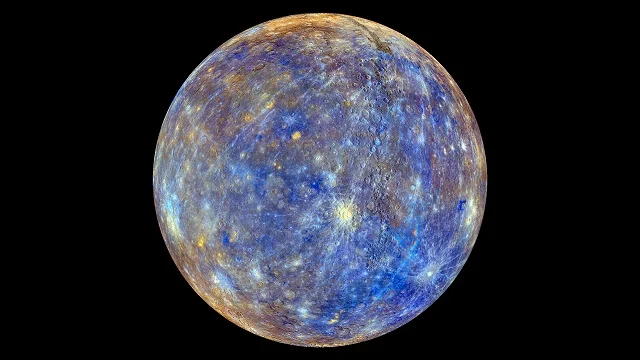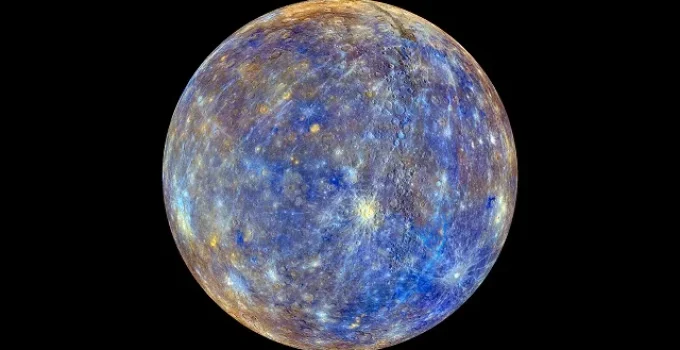Dive Deeper
- Why Doesn’t Mercury Have Any Moons?
- Mercury’s Location and the Sun’s Gravity
- How Moons Form Around Planets
- Could Mercury Have Had Moons in the Past?
- Why Do Some Planets Have Many Moons?
- 🎯 Final Thoughts
- 📚 References
Why Doesn’t Mercury Have Any Moons?

Image Credit: NASA/Johns Hopkins University Applied Physics Laboratory/Carnegie Institution of Washington
When we look at planets like Jupiter, which has 95 moons, or Saturn, with its over 145 confirmed moons, it’s natural to wonder: Why doesn’t Mercury have any moons at all? In fact, Mercury and Venus are the only two planets in our solar system with zero natural satellites. Scientists have several good reasons why this is the case—and it all comes down to gravity, location, and size.
Mercury is the closest planet to the Sun. It’s small, fast, and lives in one of the harshest spots in the solar system. These factors make it nearly impossible for Mercury to keep a moon in orbit.
Mercury’s Location and the Sun’s Gravity
The number one reason Mercury has no moons is the Sun’s powerful gravity. Since Mercury orbits so close to the Sun, any small object that might try to orbit Mercury could be easily pulled away by the Sun’s gravity.
To better understand this, think of gravity like a game of tug-of-war. In Mercury’s case:
- The Sun is huge and very strong.
- Mercury is small and has weaker gravity.
- If a moon tried to orbit Mercury, the Sun would likely win the tug-of-war and steal the moon away.
This means Mercury doesn’t have a big enough “gravitational reach” to hold onto a moon. That reach is called the Hill sphere—and Mercury’s Hill sphere is very small.
📊 Fact: Mercury’s Hill sphere only extends about 1.3 million kilometers. In comparison, Earth’s Hill sphere is about 1.5 million kilometers, even though it’s farther from the Sun [1].
How Moons Form Around Planets
Moons can form in a few different ways:
- Capture: A planet’s gravity grabs a passing asteroid or object.
- Collision: A large impact knocks debris into orbit, which forms a moon (like Earth’s Moon).
- Formation Together: The planet and moon form at the same time from the same materials.
Mercury likely never had the chance for any of these to work:
- Capture? Too close to the Sun. The Sun’s gravity would pull the object away.
- Collision? Possible, but the debris might have either fallen back to Mercury or escaped into space.
- Formation Together? If it had a moon early on, it probably couldn’t keep it.
Could Mercury Have Had Moons in the Past?
Some scientists believe that Mercury might have had a moon long ago. One idea is that a large collision early in Mercury’s history could have created a moon, just like Earth’s Moon formed.
But if Mercury ever had a moon, it probably didn’t last long. Over time:
- The Sun’s gravity could have pulled it away.
- Tidal forces between Mercury and the moon might have made the moon spiral in and crash.
- The small size of Mercury made it harder to hold onto anything in orbit.
So while Mercury could have had a moon in the past, there’s no evidence that it still does—or that it lasted very long if it ever existed.
Why Do Some Planets Have Many Moons?
Let’s compare Mercury to some of the other planets:
| Planet | Number of Moons | Distance from Sun | Size and Gravity |
|---|---|---|---|
| Mercury | 0 | 1st planet | Small, low gravity |
| Earth | 1 | 3rd planet | Medium gravity |
| Jupiter | 95 | 5th planet | Massive gravity |
| Saturn | 145+ | 6th planet | Massive gravity |
Planets that are larger and farther from the Sun tend to have more moons. This is because:
- They have stronger gravity to pull things in.
- They are less affected by the Sun’s gravity, so they can hold onto their moons.
- There are more icy or rocky objects nearby in the outer solar system to capture.
🎯 Final Thoughts
Mercury doesn’t have any moons, and that makes perfect sense when you consider its environment. It’s a small planet, very close to the Sun, and doesn’t have enough gravity to hold onto a moon. Even if it ever did have one, the Sun likely pulled it away—or it crashed into the planet long ago.
While Mercury may be moonless, it’s still a fascinating world with a massive iron core, extreme temperatures, and a unique place in our solar system. Its lack of moons reminds us how different planets can be, even in the same cosmic neighborhood.
📚 References
- NASA Solar System Exploration – Mercury Overview: https://solarsystem.nasa.gov/planets/mercury/overview/
- Williams, David R. “Planetary Fact Sheet – Metric.” NASA Goddard Space Flight Center. https://nssdc.gsfc.nasa.gov/planetary/factsheet/
- Lissauer, J. J., & de Pater, I. Fundamental Planetary Science. Cambridge University Press, 2013.
- ESA – “Why Mercury and Venus Have No Moons.” https://www.esa.int/Science_Exploration/Space_Science/Moons_and_their_Origins
- Malhotra, R. “Tidal Evolution of Planets and Moons.” Annual Review of Astronomy and Astrophysics, 1998.
